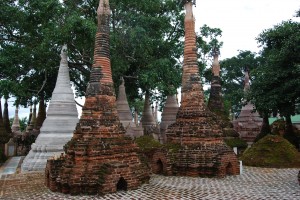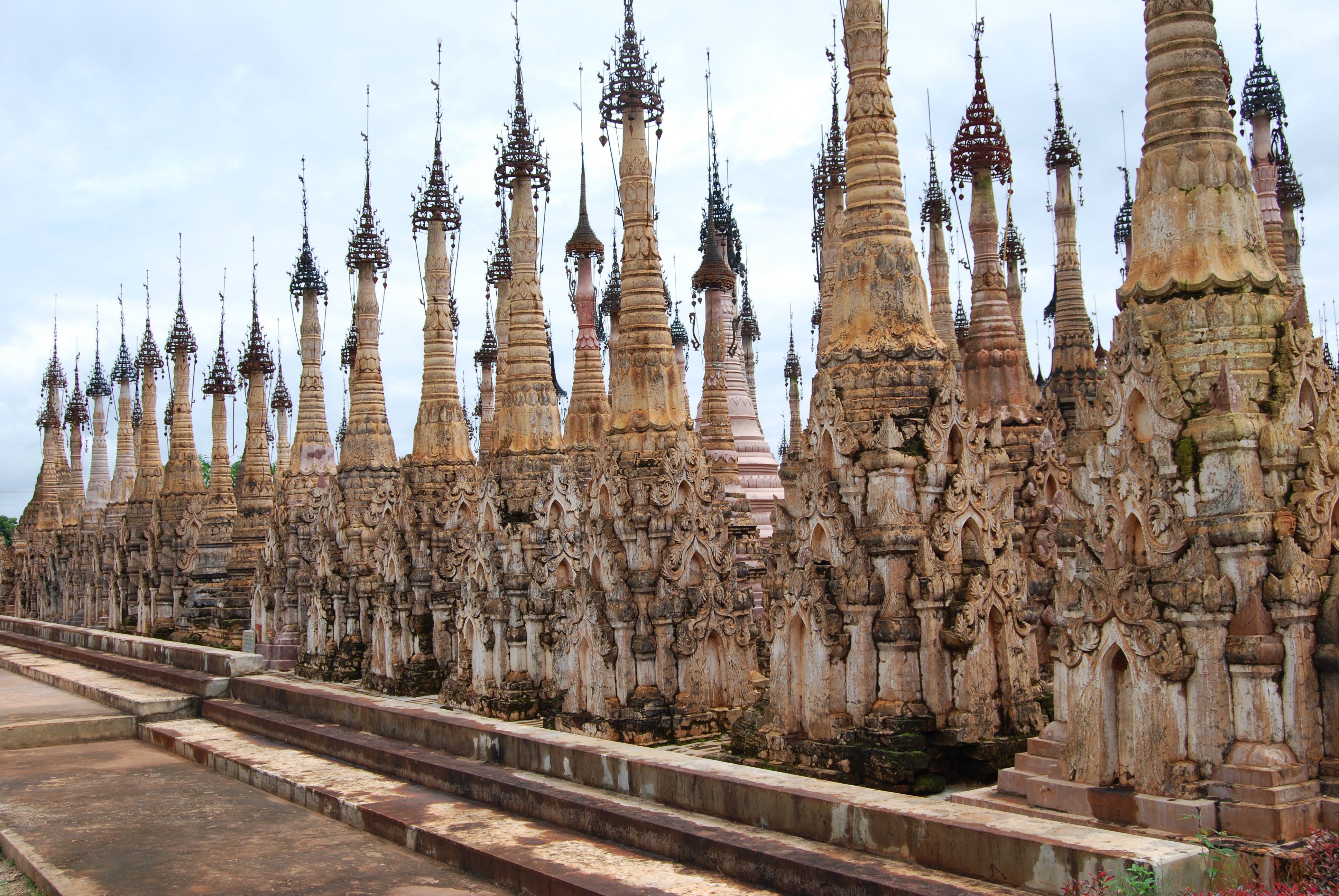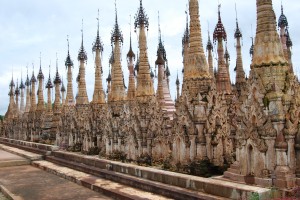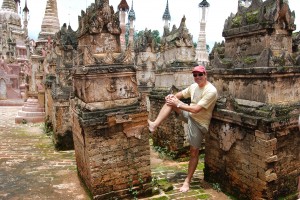What we need is more stupas
14 August 2010….If you venture north of Inle Lake, around the mountains and up a windy narrow road you come to a little village called Kakku. And near the village we found one of the most amazing, totally unexpected and bit bizarre scenes of our whole time in Myanmar. Yes, more stupas.
But not just more stupas, or more chedis, or more zetis. Much more. In fact, sitting on top of this small knoll surrounded by beautiful mountains all around and carrying a sense of remoteness we haven’t felt on the trip so far, was line after line, row after row, acre after acre, of stupas. And then there were more stupas, in fact, over 2,500 of the buggers. That’s a lot of stupas, no matter what you call them.
On our drive up to Kakku we stopped in the provincial capital called Taungghi to pay a mandatory ‘donation’ and pick up our guide for the day (the only time in the entire trip where we had to have a guide by government decree). And so we met a young girl named Nitnoi who joined us for our trip up into the mountains. Nitnoi was from the Pa-O tribe that we had seen at Inle Lake and she wore the bright orange towel/scarf around her head.

- The handsome old ones and the ugly renovated ones
This was a fabulous drive through the fields and rolling hills on a poorlymaintained secondary road which in most sections was only wide enough for one vehicle (which was adequate because there was virtually no traffic). The fields were covered in very healthy corn, soy beans, peanuts and rice. The rainy season is a wonderful thing and clearly the local farmers were having a good season.
But again, as we’ve seen before, all of the field work was done by animal and man – no mechanical devices at all. We passed countless scenes of bullocks pulling plows, horse carts with their over-sized wooden wheels transporting people and goods and water buffaloes reluctantly acting as beasts of burden. We knew from our driver earlier that only about one-third of these villages have electricity, the others rely on generators or just candles and lamps inside their modest mat homes.
From what we gathered from Nitnoi, the stupas of Kakku were built from the 12th to the 18th century when various kings, princes, noblemen, villages and families built a structure to show their local wealth or their devotion to their religion or to make merit. It was interesting to follow the different styles and designs of the stupas depending on the century they were built, and to see the states of repair.
Sadly it seemed to us most of the renovation that had happened or is still happening to these stupas have completely changed the look, shape and details of the originals. Most of the renovated structures were just smoothly plastered over without any artistic merit or religious symbols. Many had little plaques saying their renovation was due to donations from some organisation in Singapore or Thailand but to be honest I wouldn’t want my name on any of those renovation jobs. We tended to shy away from these bland plain colourless stupas and spent more time admiring the old original ones, even if their conditions were poor – at least they retained their original spirit and intent.
So when it comes to visiting Kakku my advice would be to come quickly before the do-gooders ruin the place.
We were invited to join them for lunch where we sat on their mat floor and were handed beautiful ears of corn straight out of the boiling water, still with their husks on. We peeled the husks to find beautiful multi-coloured corn kernels cooked to perfection. What a treat to be sitting in their home sharing their mid day meal.
We asked our guide Nitnoi a lot of questions about Kakku and life in Myanmar. Her English was good, mainly learned from a government tutor, and she obviously had a valued job. She said Kakku was only opened for tourists about 10 years ago and was ‘very popular’ with tourists. When I asked her how many tourists came to Kakku last year she said ‘many’. Yes, but approximately how many? ‘About 5,000’. I asked her how many tourists would be at Kakku today. She thought for a moment and said ‘two’. Would that be the two of us in this car? ‘Yes.’
Nitnoi had some interesting answers to my questions (which I admit was a bit of bait to see what she would say). For instance, I asked her why the farmers don’t use tractors and she said it was because the hills were too steep. I asked her about the condition of the roads and she said it was because of poor drainage (yes, poor drainage might be an issue but wouldn’t make the top 10 problems for these roads). In any case, her job was to protect the government line when I asked annoying questions and her boss would have been very proud of her.
That afternoon we drove back to Heho and flew back to Yangon, this time on Yangon Airlines. One of the amusing aspects of this trip is that since there are so few flights between the towns and really only four main places tourists go we tend to recognise each other and sorta regroup at the airport for our next flight. Usually we don’t see these people between flights as we stay in different hotels and have different daily schedules but like clock work we join back up at the airport for the next flight.
And so it goes that numerous couples or families or individual travellers had basically the same itinerary as us. And Julie in particular would say hello and wasn’t that great and isn’t it funny we keep bumping into each other. Virtually all of the tourists were Europeans with Italians strongly dominating, then the French and Spanish. No English or Australians or Americans. But lotsa Italians.
So the usual routine at the airport, including the little sticker they put on your shirt. We frequently joked about how people would forget about their little sticker and keep it on the rest of the day. This was a source of constant amusement and sure enough, that night in Yangon when Julie and I popped around the corner to a little local bar to enjoy another Myanmar beer there was the single Japanese guy who we first saw in Bagan, then Inle Lake and now back in Yangon again. And sure enough, as he sat there amongst the locals enjoying his beer there was his little sticker still on his shirt. Another example of the pitfalls of travelling alone.










Comments
What we need is more stupas — No Comments
HTML tags allowed in your comment: <a href="" title=""> <abbr title=""> <acronym title=""> <b> <blockquote cite=""> <cite> <code> <del datetime=""> <em> <i> <q cite=""> <s> <strike> <strong>